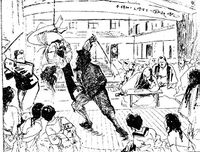Difference between revisions of "History of SM Shows"
From Nawapedia
Jump to navigationJump to search| Line 1: | Line 1: | ||
[https://smpedia.com/index.php?title=SMショーの歴史 SMショーの歴史] | [https://smpedia.com/index.php?title=SMショーの歴史 SMショーの歴史] | ||
| − | The history below is an inclusive categorization of bondage, torment and/or erotic sadomasochism in live theater | + | The history below is an inclusive categorization of bondage, torment and/or erotic sadomasochism in live theater in Japan. |
{| align="right" | {| align="right" | ||
| Line 23: | Line 23: | ||
==Modern Theater== | ==Modern Theater== | ||
2014: Oct. "Nagauta Bo Shibari" at Kameari Lirio Hall | 2014: Oct. "Nagauta Bo Shibari" at Kameari Lirio Hall | ||
| − | |||
==Pink Live Shows== | ==Pink Live Shows== | ||
==SM Shows== | ==SM Shows== | ||
| − | |||
| − | |||
==Notes== | ==Notes== | ||
Revision as of 10:58, 21 January 2022
The history below is an inclusive categorization of bondage, torment and/or erotic sadomasochism in live theater in Japan.
 “Flesh Market” at the Kannon Theater in Asakusa. From Seiu Ito’s “Non-Fiction - Sexual Fluids (11)”. Kitan Club Dec 1954 issue. |
Edo Period Theater
1678: "Sansho Dayu Anju-Hime," in Moronobu Hishikawa's "The Story of Actors Past and Present."[※ 1] Itahashiya-Hime is abused with her hands tied behind her back. By this time, torment scenes were already being hinted at in kabuki theater.
1700s: Punishment scenes in kabuki and ningyō jōruri (puppet theater accompanied by shamisen) are thought to rattle a person's mind.[citation needed]
1740: "Steps of Chujohime's Torment" (step three from "The Mountain Goddess Sutematsu" by Namiki Sousuke).
1772: "Akegarasu Yume no Awayuki"[1]
Meiji Theater
Modern Theater
2014: Oct. "Nagauta Bo Shibari" at Kameari Lirio Hall
Pink Live Shows
SM Shows
Notes
- ↑ A work of Shinnai jōruri recitation
References (※)
- ↑ Edo Period Literature (Tosho Kankokai, 1916)